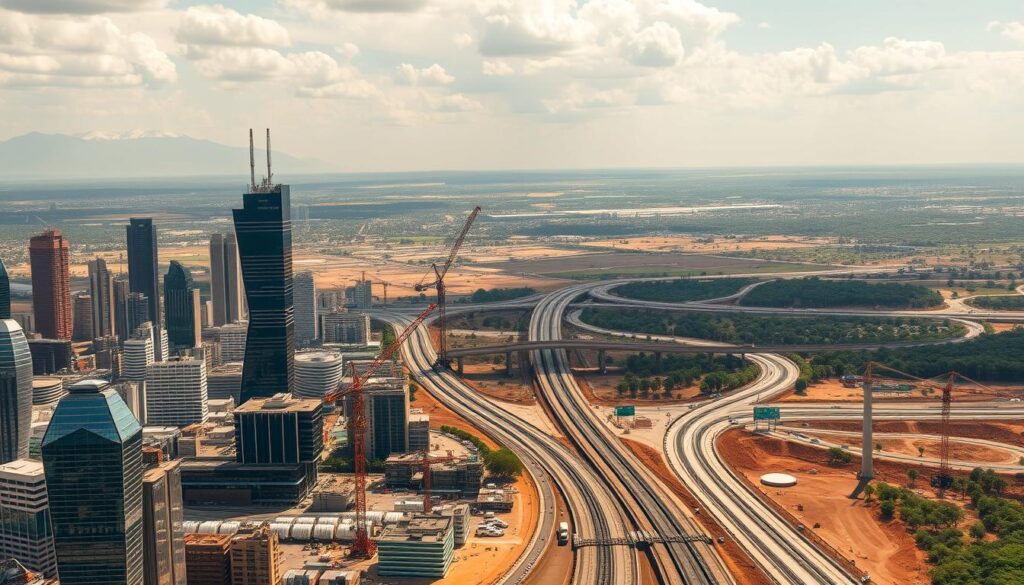Are significant infrastructure developments the key to unlocking Africa’s economic potential? The continent is witnessing a surge in transformative projects that are reshaping its landscape.
Countries across Africa are making significant strides in infrastructure development, including energy, transport, and digital infrastructure, as reported by Business Insider Africa. This development is not only modernizing the continent’s infrastructure but also boosting economic growth and improving the quality of life for its inhabitants.
Key Takeaways
- Africa is experiencing a significant surge in infrastructure development.
- Energy, transport, and digital infrastructure are key areas of focus.
- These developments are crucial for boosting economic growth.
- Countries like South Africa and Egypt are leading in infrastructure investments.
- Infrastructure projects are improving the quality of life across the continent.
Introduction to African Infrastructure Development
Africa’s infrastructure landscape is undergoing a significant transformation, driven by investments in energy, transportation, and digital networks. As the continent continues to grow and develop, the need for robust infrastructure becomes increasingly evident.
Overview of Infrastructure Challenges
Despite the progress being made, Africa still faces significant infrastructure challenges. These include inadequate transportation networks, insufficient energy supply, and limited access to digital connectivity in rural areas. The lack of infrastructure hinders economic growth, making it difficult for businesses to operate efficiently and for communities to access essential services.
Addressing these challenges requires a multi-faceted approach that involves government investment, private sector participation, and international cooperation. By working together, stakeholders can develop infrastructure that meets the needs of Africa’s growing population and supports economic development.
Importance of Infrastructure in Economic Growth
Infrastructure plays a critical role in driving economic growth in Africa. By reducing transaction costs, improving productivity, and attracting investment, infrastructure development can have a positive impact on the economy. For instance, improved transportation networks can facilitate the movement of goods and people, while reliable energy supply can support business operations and economic activity.
Moreover, infrastructure development can also have social benefits, such as improved access to healthcare, education, and other essential services. As Africa continues to urbanize, the demand for infrastructure will only continue to grow, making it essential to prioritize investment in this area.
Project1: The African Union’s Programme for Infrastructure Development
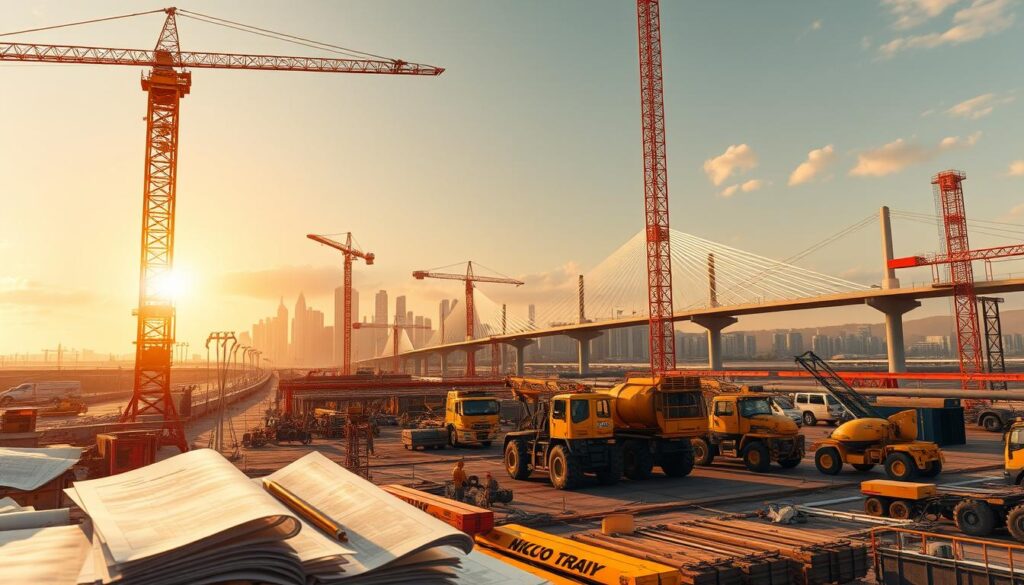
Africa’s economic future is being shaped by the African Union’s comprehensive infrastructure development initiative. This program is designed to promote economic growth and development through improved infrastructure, enhancing the continent’s global competitiveness.
Goals and Objectives
The primary goal of the African Union’s Programme for Infrastructure Development is to foster economic integration and development across the continent. The program aims to achieve this by improving the quality and extent of Africa’s infrastructure, including transportation networks, energy systems, and information and communication technology (ICT) infrastructure.
Key objectives include enhancing regional connectivity, promoting economic development, and improving the quality of life for African citizens. By achieving these objectives, the program seeks to stimulate economic growth, create jobs, and attract investment into the continent.
Key Projects Under the Programme
The program encompasses a wide range of projects, including the development of transnational highways, railway networks, and seaports. These projects are crucial for enhancing regional trade and connectivity, facilitating the movement of goods and people across borders.
Some of the notable projects under this program include initiatives to upgrade and expand Africa’s energy infrastructure, ensuring greater access to reliable and sustainable energy. The program also focuses on developing ICT infrastructure, which is vital for supporting the continent’s growing digital economy.
By investing in these critical infrastructure projects, the African Union aims to drive economic transformation and improve the livelihoods of millions of Africans. The success of this program will depend on effective implementation, collaboration among member states, and the ability to attract significant investment from both public and private sources.
Project2: The Grand Ethiopian Renaissance Dam
As one of Africa’s most ambitious infrastructure endeavors, the Grand Ethiopian Renaissance Dam is set to revolutionize the continent’s energy landscape. This monumental project is not only a significant step for Ethiopia but also a crucial development for the entire region.
Overview and Purpose
The Grand Ethiopian Renaissance Dam, located on the Blue Nile River, is Ethiopia’s largest hydroelectric project. Its primary purpose is to generate electricity, significantly boosting Ethiopia’s power generation capacity and enabling it to become a major electricity exporter to neighboring countries.
The dam is expected to have a total installed capacity of over 6,000 MW, making it one of the largest hydroelectric power plants in Africa. This infrastructure project is crucial for meeting the growing energy demands of the region and supporting economic development.
Environmental and Economic Impact
The construction of the Grand Ethiopian Renaissance Dam has raised discussions about its environmental impact. While there are concerns about the dam’s effect on the Nile’s ecosystem and the potential displacement of local communities, the project is also seen as a vital step towards reducing the region’s reliance on fossil fuels and mitigating climate change.
Economic benefits are also anticipated, as the dam is expected to increase Ethiopia’s GDP and provide electricity to millions of people. According to reports, the dam could potentially enhance regional cooperation and energy security.
The Grand Ethiopian Renaissance Dam is a significant example of major infrastructure projects in Africa that are transforming the continent’s energy landscape and boosting economic growth. As such projects continue to develop, they are likely to play a crucial role in shaping Africa’s future.
Project3: The LAPSSET Corridor Project in Kenya
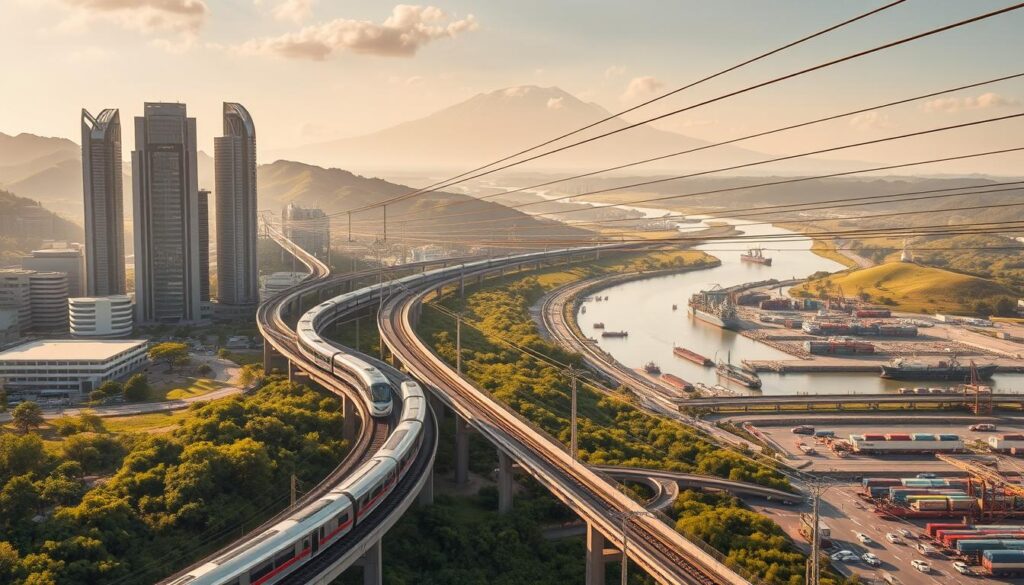
As part of its infrastructure development, Kenya has embarked on the ambitious LAPSSET Corridor Project, a multi-faceted initiative aimed at enhancing regional connectivity and economic activity. The project is a cornerstone of Kenya’s strategy to boost its economy through improved infrastructure.
Components of the Project
The LAPSSET Corridor Project encompasses several key components designed to transform Kenya’s infrastructure landscape. These include:
- A railway line connecting Lamu to Juba in South Sudan and to Moyale in Ethiopia.
- A highway that will facilitate the movement of goods and people across the region.
- Port development at Lamu, which will enhance maritime trade.
- An oil pipeline to transport oil from South Sudan and Ethiopia to the Kenyan coast.
- Three resort cities along the coast to boost tourism.
These components are designed to work in tandem to create a robust infrastructure network that supports economic growth and regional integration.
Expected Economic Benefits
The LAPSSET Corridor Project is expected to have a profound impact on Kenya’s economy and the wider region. Some of the anticipated benefits include:
- Economic Growth: By improving infrastructure, the project is expected to stimulate economic growth by facilitating trade and investment.
- Job Creation: The construction and operational phases of the project are likely to create numerous job opportunities, both directly and indirectly.
- Regional Integration: By connecting Kenya with its neighbors, the project will enhance regional integration, promoting economic cooperation and development.
The LAPSSET Corridor Project is a significant step towards realizing Kenya’s vision of becoming a major economic hub in the region. Its successful implementation will not only boost Kenya’s economy but also contribute to the broader goal of African infrastructure growth.
Project4: The Trans-African Highways Network
With the potential to transform Africa’s transportation landscape, the Trans-African Highways Network is a critical project for the continent’s economic future. The network aims to create a unified road system that connects various regions, enhancing the movement of goods and services.
Importance of a Unified Road Network
A unified road network is essential for promoting economic integration and intra-African trade. By improving road connectivity, the Trans-African Highways Network can significantly reduce transportation costs and times, making African goods more competitive in both local and international markets.
The benefits of a unified road network extend beyond economic gains. It also facilitates cultural exchange, tourism, and the overall integration of African countries.
Current Progress and Challenges
The Trans-African Highways Network has made significant progress since its inception. Several key routes have been identified and are under various stages of development. For instance, the LAPSSET project report highlights the importance of such infrastructure projects in boosting regional connectivity.
Despite the progress, the project faces several challenges, including funding constraints, political instability in some regions, and environmental concerns. Addressing these challenges is crucial for the successful completion of the network.
| Aspect | Description | Impact |
|---|---|---|
| Economic Integration | Enhanced road connectivity | Increased trade and economic growth |
| Intra-African Trade | Reduced transportation costs and times | Improved competitiveness of African goods |
| Regional Connectivity | Improved road infrastructure | Enhanced cultural exchange and tourism |
Project5: The Abuja-Kaduna Railway in Nigeria
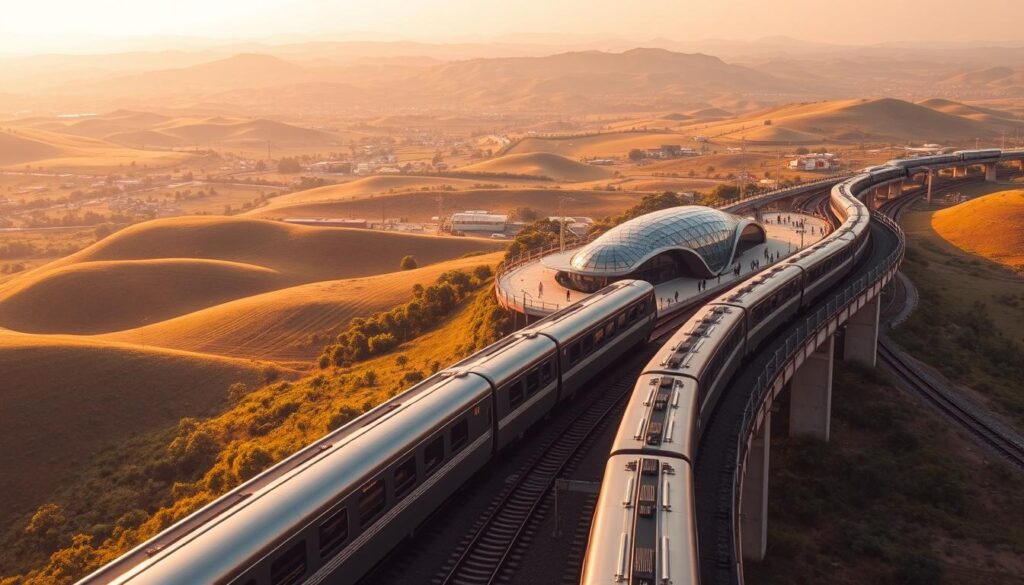
A major boost to Nigeria’s transportation network, the Abuja-Kaduna Railway is revolutionizing travel and commerce. This significant infrastructure project is aimed at improving connectivity between the nation’s capital, Abuja, and Kaduna, a major commercial center.
Project Overview and Benefits
The Abuja-Kaduna Railway is a critical infrastructure development in Nigeria, designed to enhance the efficiency and safety of passenger and freight rail transport. By reducing travel time between Abuja and Kaduna from several hours by road to under two hours by train, this project is set to boost economic activity by facilitating faster movement of goods and people.
The railway is expected to have a positive impact on the economy by reducing transportation costs and increasing the competitiveness of Nigerian businesses. As noted by a railway expert, “The Abuja-Kaduna Railway is a game-changer for Nigeria’s economy, offering a reliable and efficient mode of transport that will stimulate economic growth.”
“The Abuja-Kaduna Railway is a significant step forward in Nigeria’s infrastructure development, enhancing connectivity and fostering economic growth.”
Challenges and Future Prospects
Despite its benefits, the Abuja-Kaduna Railway faces several challenges, including operational and maintenance issues. Ensuring the railway operates at optimal levels will be crucial to its long-term success.
Future prospects for the Abuja-Kaduna Railway include potential expansion plans and integration with other rail networks across Nigeria and the wider African region. As part of Nigeria’s broader infrastructure development strategy, this railway is poised to play a key role in the country’s economic development.
The success of the Abuja-Kaduna Railway could serve as a model for other infrastructure projects in Africa, demonstrating the potential for railway development to drive economic growth. As Africa continues to invest in its infrastructure, projects like the Abuja-Kaduna Railway will be crucial in shaping the continent’s economic future.
Project6: The Walvis Bay to Ndola Railway in Southern Africa
The Walvis Bay to Ndola Railway is a pivotal infrastructure project in Southern Africa, aimed at enhancing regional trade and economic integration. This railway line connects the port city of Walvis Bay in Namibia to Ndola in Zambia, facilitating the transportation of goods across the region.
Economic Significance
The Walvis Bay to Ndola Railway holds significant economic importance for the region. By providing a direct and efficient rail link between Namibia and Zambia, it reduces transportation costs and times, thereby boosting trade between the two countries and beyond.
Key economic benefits include:
- Enhanced connectivity between landlocked Zambia and the coastal port of Walvis Bay
- Reduced transportation costs for goods
- Increased trade volumes between Namibia, Zambia, and other regional countries
Regional Trade Enhancement
The railway project is a crucial component of regional trade enhancement strategies. By improving infrastructure, it facilitates the movement of goods, services, and people, thereby fostering economic cooperation and development.
| Country | Economic Impact | Trade Volume Increase |
|---|---|---|
| Namibia | Boost in port activities and related services | 20% |
| Zambia | Improved access to international markets | 15% |
| Regional | Enhanced regional trade and cooperation | 25% |
The Walvis Bay to Ndola Railway is a testament to the potential of major infrastructure projects in Africa to drive economic growth and regional integration.
Project7: The Johannesburg-Durban High-Speed Rail Link
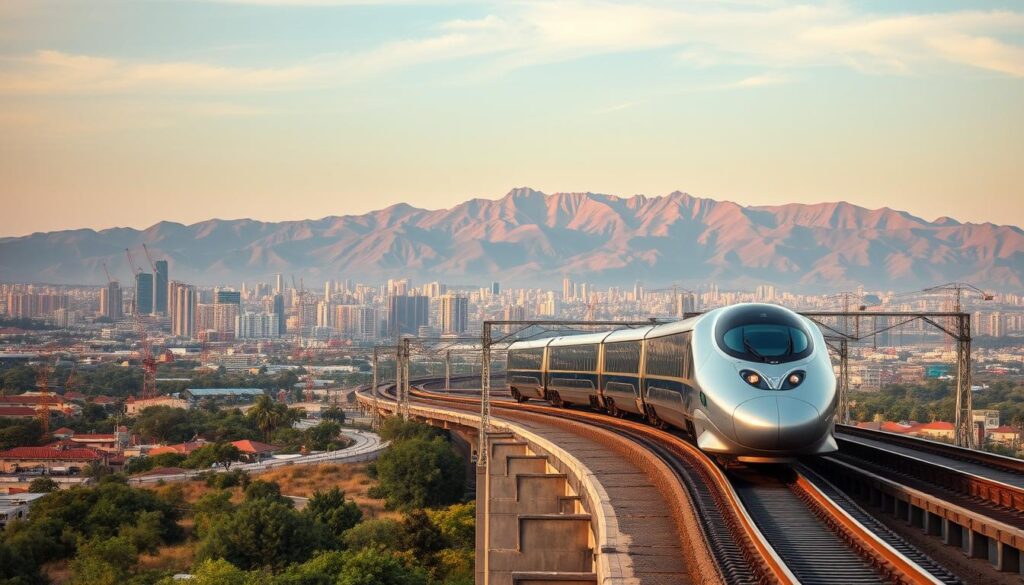
The introduction of the Johannesburg-Durban High-Speed Rail Link marks a significant milestone in African infrastructure development. This project is one of the top infrastructure initiatives in Africa, aimed at enhancing transportation infrastructure and facilitating trade across the region.
Overview of the Project
The Johannesburg-Durban High-Speed Rail Link is a major railway project designed to connect two of South Africa’s key cities: Johannesburg and Durban. This high-speed rail link will significantly reduce travel time between the two cities, from the current approximately 10 hours by car to just under 3 hours by train.
The project involves the construction of new railway lines, upgrading existing infrastructure, and implementing advanced signaling systems to ensure safe and efficient travel. The rail link is expected to have a substantial impact on both passenger and freight transportation.
Anticipated Impact on Travel and Trade
The Johannesburg-Durban High-Speed Rail Link is anticipated to have a profound impact on both travel and trade in the region. By reducing travel times and increasing the efficiency of transportation, the project is expected to boost economic activity. It will make it easier for people to travel for business, leisure, and education, thereby fostering greater connectivity and economic integration.
For trade, the high-speed rail link will provide a faster and more reliable means of transporting goods between Johannesburg and Durban, one of South Africa’s key ports. This will enhance the competitiveness of South African businesses in the global market and stimulate economic growth.
| Aspect | Current Status | Expected Outcome |
|---|---|---|
| Travel Time | 10 hours by car | Under 3 hours by train |
| Economic Impact | Limited connectivity | Boost in economic activity |
| Freight Transport | Inefficient logistics | Faster and reliable goods transport |
The Johannesburg-Durban High-Speed Rail Link is a testament to African infrastructure growth and a significant step towards enhancing infrastructure investment in Africa. As one of the flagship projects in the region, it sets a precedent for future infrastructure development initiatives.
Project8: The Mombasa-Nairobi Standard Gauge Railway
With the launch of the Mombasa-Nairobi Standard Gauge Railway, Kenya has taken a significant step towards modernizing its transportation network. This railway is not only a crucial part of Kenya’s infrastructure development but also a significant contributor to the regional economy.
Project Details and Background
The Mombasa-Nairobi Standard Gauge Railway is a key infrastructure project that has transformed the way goods and people move between Kenya’s major cities. Spanning over 472 kilometers, this railway connects the port city of Mombasa to Nairobi, the capital city, significantly reducing travel time and increasing the efficiency of goods transportation.
The project was undertaken to address the growing demand for transportation infrastructure in Kenya and to support the country’s economic growth. By providing a faster and more reliable mode of transport, the railway has enhanced connectivity between Mombasa and Nairobi, facilitating trade and economic activities.
Economic Ripples Across East Africa
The impact of the Mombasa-Nairobi Standard Gauge Railway extends beyond Kenya’s borders, contributing to the economic integration of East Africa. By improving access to the port of Mombasa, the railway has boosted regional trade, benefiting neighboring countries such as Uganda, Rwanda, and South Sudan.
According to reports, the railway has reduced transportation costs and times, making Kenyan goods more competitive in the regional market. This development is part of a broader trend of major infrastructure projects in Africa aimed at boosting economic activity and promoting regional integration.
The railway is a testament to the potential of infrastructure development to drive economic growth and improve living standards in Africa. As such, it serves as a model for other infrastructure projects across the continent, highlighting the importance of investing in transportation networks to support economic development.
Project9: Renewable Energy Projects in Africa
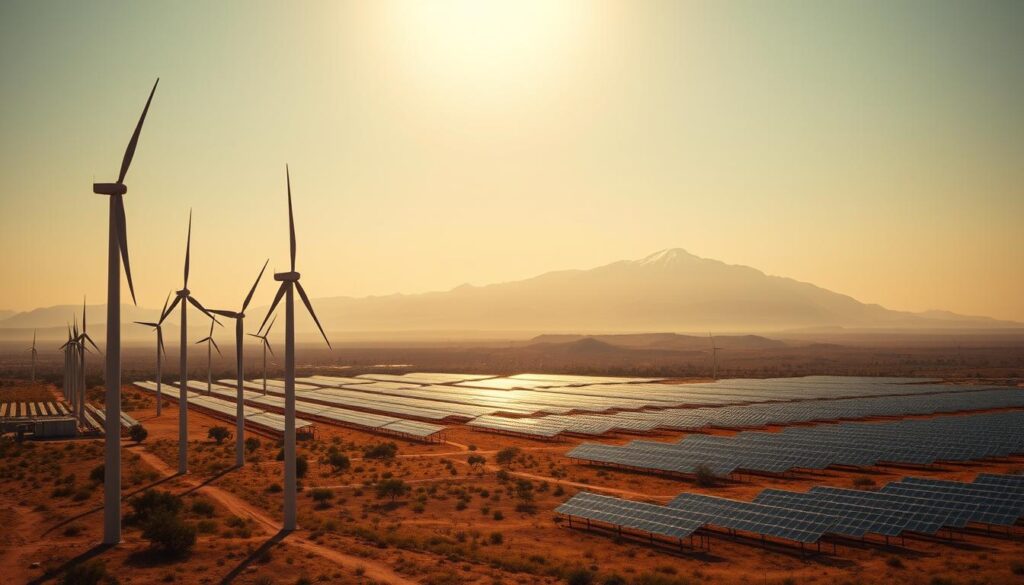
The shift towards renewable energy is gaining momentum across Africa, driven by the need for sustainable development. As the continent continues to grow economically, the demand for energy is increasing, making renewable energy sources a vital component of Africa’s infrastructure growth.
Overview of Solar and Wind Initiatives
Africa is rich in solar and wind resources, making it an ideal location for renewable energy projects. Solar energy initiatives are being implemented across the continent, with countries like South Africa and Egypt leading the way. For instance, the report on renewable energy highlights various projects that are contributing to the growth of solar energy in Africa.
Wind energy is another area where Africa is making significant strides. Countries such as Kenya and Morocco are investing heavily in wind farms to generate electricity. These initiatives not only help in reducing reliance on fossil fuels but also contribute to the overall energy mix, enhancing energy security.
Impact on Energy Access and Sustainability
The impact of these renewable energy projects on energy access and sustainability is profound. By increasing the availability of clean energy, these projects are helping to reduce energy poverty and promote sustainable development. Moreover, they are contributing to a reduction in greenhouse gas emissions, aligning with global efforts to combat climate change.
Furthermore, renewable energy projects are creating new economic opportunities in Africa. They are generating employment and stimulating local economies, thereby contributing to the overall infrastructure investment in Africa. As these projects continue to grow, they are expected to play a crucial role in shaping the future of energy in Africa.
Project10: The Mozambique LNG Project
One of Africa’s most promising infrastructure projects, the Mozambique LNG Project, is set to revolutionize the region’s energy landscape. This significant undertaking involves the development of Mozambique’s vast natural gas reserves, aiming to boost the country’s economy and enhance regional energy security.
Overview of the Natural Gas Project
The Mozambique LNG Project is a major infrastructure initiative that will enable the extraction and processing of natural gas from the Rovuma Basin, off the coast of Mozambique. This project is being led by a consortium of international energy companies, including TotalEnergies, ExxonMobil, and Eni, among others. The project will involve the construction of liquefied natural gas (LNG) processing facilities, which will allow for the export of LNG to global markets.
The development of this project is expected to have a significant impact on Mozambique’s economy, creating new revenue streams and job opportunities. The project will also contribute to the diversification of the country’s energy mix, enhancing energy security and reducing reliance on traditional energy sources.
Economic and Social Implications
The Mozambique LNG Project is anticipated to have far-reaching economic and social implications for the country and the region. On the economic front, the project is expected to generate substantial revenue for the Mozambican government through taxes and royalties. This increased revenue will enable the government to invest in critical infrastructure, such as roads, schools, and healthcare facilities, thereby improving the quality of life for local communities.
From a social perspective, the project will create new employment opportunities, both directly and indirectly, contributing to the local economy. However, it is also important to consider the potential social impacts, including the need for resettlement of local communities and the management of environmental risks associated with the project.
| Economic Benefits | Social Implications | Environmental Considerations |
|---|---|---|
| Revenue generation through taxes and royalties | Creation of new employment opportunities | Management of environmental risks |
| Investment in critical infrastructure | Resettlement of local communities | Implementation of environmental mitigation measures |
| Contribution to GDP growth | Improved quality of life for local communities | Monitoring of environmental impacts |
In conclusion, the Mozambique LNG Project represents a significant infrastructure development in Africa, with the potential to transform Mozambique’s economy and contribute to regional energy security. While there are challenges to be addressed, the project’s economic and social benefits make it an important undertaking for the country’s future.
Challenges Facing Infrastructure Development in Africa
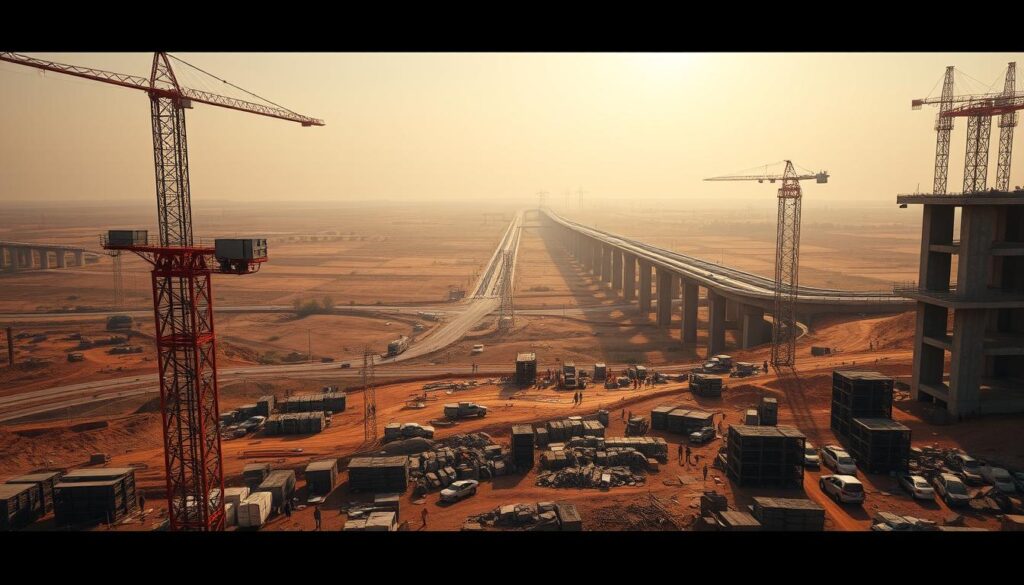
Africa’s infrastructure growth is challenged by various factors that need to be addressed to ensure the successful implementation of infrastructure projects. Despite the progress made in recent years, the continent still faces significant hurdles in developing its infrastructure.
Funding and Investment Barriers
One of the primary challenges facing infrastructure development in Africa is the lack of sufficient funding and investment. Many African countries struggle to secure the necessary funds to finance large-scale infrastructure projects. According to recent reports, the infrastructure financing gap in Africa is substantial, with estimates suggesting that the continent needs to invest at least $130 billion annually to meet its infrastructure needs.
The lack of investment is attributed to various factors, including perceived risk by investors, limited financial markets, and inadequate fiscal frameworks. To address this challenge, African governments are increasingly seeking partnerships with international organizations and foreign governments to secure funding and expertise for their infrastructure projects.
| Region | Infrastructure Investment Needs ($ billion) | Current Investment ($ billion) | Gap ($ billion) |
|---|---|---|---|
| East Africa | 50 | 20 | 30 |
| West Africa | 40 | 15 | 25 |
| Southern Africa | 30 | 10 | 20 |
Political and Social Factors
Political and social factors also play a significant role in hindering infrastructure development in Africa. Political instability, corruption, and inadequate regulatory frameworks can deter investment and hinder the progress of infrastructure projects. For instance, projects are often delayed or canceled due to changes in government or political unrest.
Furthermore, social factors such as community displacement and environmental concerns can also impact infrastructure development. It is essential for governments and project developers to engage with local communities and address their concerns to ensure the successful implementation of infrastructure projects.
For more insights on Africa’s infrastructure development, visit Africa’s infrastructure revolution to explore the progress, innovations, and challenges in detail.
The Role of International Partnerships
Global organizations and foreign governments are playing a crucial role in supporting top infrastructure initiatives in Africa. International partnerships are essential for the success of major infrastructure projects, bringing in not only financial investment but also technological expertise and managerial know-how.
Collaborations with Global Organizations
Collaborations with global organizations such as the World Bank, African Development Bank, and the United Nations are pivotal. These organizations provide financial support, technical assistance, and policy guidance to countries undertaking major infrastructure projects. For instance, the World Bank has been instrumental in funding several key infrastructure projects across Africa, including transportation networks and energy systems.
The African Development Bank has also been at the forefront, providing financing and technical assistance for infrastructure development. Its initiatives include improving road networks, enhancing energy production, and developing water resources. Such collaborations are crucial for the success of infrastructure investment in Africa.
| Global Organization | Projects Supported | Impact |
|---|---|---|
| World Bank | Transportation networks, energy systems | Improved connectivity, increased energy access |
| African Development Bank | Road networks, energy production, water resources | Enhanced infrastructure, economic growth |
Support from Foreign Governments
Support from foreign governments is another critical component of international partnerships in Africa’s infrastructure development. Countries like China, the United States, and several European nations are involved in financing and executing major infrastructure projects in Africa. For example, China’s Belt and Road Initiative has led to significant investments in transportation infrastructure across the continent.
Foreign governments bring not only financial resources but also technological expertise. This support is vital for the implementation of complex infrastructure projects, such as high-speed rail links and advanced telecommunications networks. The involvement of foreign governments in major infrastructure projects in Africa underscores the global interest in the continent’s development.
In conclusion, international partnerships are a cornerstone of Africa’s infrastructure development. Through collaborations with global organizations and support from foreign governments, the continent is witnessing significant advancements in its infrastructure landscape. These partnerships are crucial for the realization of top infrastructure initiatives in Africa, driving economic growth and improving the quality of life for millions of people.
Future Trends in African Infrastructure Development

Technological advancements and a shift towards sustainable practices are set to redefine Africa’s infrastructure growth trajectory. As the continent continues to develop, it is embracing innovative solutions to meet its growing infrastructure needs.
Technological Innovations
The integration of technology in African infrastructure development is transforming the way projects are conceptualized, executed, and maintained. Digital technologies such as IoT, AI, and blockchain are being leveraged to create smart infrastructure that is efficient, resilient, and adaptable to future challenges.
Some of the key technological innovations include:
- Smart grids for efficient energy distribution
- Intelligent transportation systems for enhanced mobility
- Advanced water management systems for sustainable use
Shift Towards Sustainable Development
Sustainability is becoming a cornerstone of infrastructure development in Africa. The shift towards sustainable development is driven by the need to mitigate environmental impacts, ensure social equity, and promote economic viability.
Key trends in sustainable infrastructure development include:
| Trend | Description | Benefits |
|---|---|---|
| Renewable Energy Integration | Incorporating solar, wind, and hydroelectric power into the energy mix | Reduced carbon footprint, energy security |
| Green Building Practices | Adopting eco-friendly materials and construction methods | Energy efficiency, reduced environmental impact |
| Sustainable Transportation | Developing electric vehicle infrastructure and non-motorized transport options | Reduced emissions, improved air quality |
As Africa continues to evolve, its infrastructure development will be shaped by the interplay of technological innovation and sustainable practices. This synergy is expected to drive the continent towards a more prosperous and sustainable future.
Conclusion: The Path Forward for Africa’s Infrastructure
Infrastructure development in Africa is pivotal for the continent’s economic future, with numerous projects underway. As we’ve explored throughout this article, various infrastructure projects are transforming the African landscape, driving economic growth, and improving living standards.
Summary of Key Takeaways
The top 10 infrastructure projects discussed in this article represent a significant step forward in Africa’s development. These projects include the African Union’s Programme for Infrastructure Development, the Grand Ethiopian Renaissance Dam, and the LAPSSET Corridor Project in Kenya, among others. Each of these initiatives has the potential to boost economic growth, enhance regional connectivity, and improve the quality of life for millions of Africans.
Key infrastructure projects are not only driving economic development but also fostering regional integration and cooperation. The Trans-African Highways Network and the Mombasa-Nairobi Standard Gauge Railway are examples of projects that are enhancing connectivity across the continent.
| Project | Economic Impact | Regional Significance |
|---|---|---|
| African Union’s Programme for Infrastructure Development | Boosts economic growth through infrastructure development | Promotes regional integration and cooperation |
| Grand Ethiopian Renaissance Dam | Generates hydroelectric power, reducing energy costs | Enhances energy security for Ethiopia and neighboring countries |
| LAPSSET Corridor Project | Stimulates economic activity through improved transportation infrastructure | Connects Kenya’s ports to the rest of the region, enhancing trade |
Call to Action for Stakeholders
As Africa continues to develop its infrastructure, it is essential for stakeholders, including governments, investors, and international organizations, to continue supporting these critical projects. Infrastructure investment in Africa is crucial for the continent’s economic future, and collaborative efforts are necessary to overcome the challenges that lie ahead.
Stakeholders must work together to address funding barriers, political instability, and other challenges that can hinder infrastructure development. By doing so, Africa can unlock its full economic potential and create a brighter future for its citizens.
In conclusion, the path forward for Africa’s infrastructure is promising, with numerous projects underway to drive economic growth and development. Continued support from stakeholders is crucial to ensure the success of these initiatives and to create a more prosperous future for Africa.
Additional Resources for Further Reading
For those interested in delving deeper into Africa’s infrastructure development, several resources are available. These include articles, publications, and relevant organizations and websites that provide valuable insights into the continent’s growth and development.
Articles and Publications
Numerous publications offer in-depth analysis on infrastructure development in Africa. Notable sources include the African Development Bank’s reports on infrastructure growth and development, as well as publications by McKinsey and Company on the top infrastructure initiatives in Africa. These resources provide comprehensive information on the progress and challenges faced by infrastructure projects across the continent.
Relevant Organizations and Websites
Several organizations are actively involved in Africa’s infrastructure development. The African Union’s infrastructure development program is a key initiative, and their website provides updates on ongoing projects. Additionally, the United Nations Economic Commission for Africa (UNECA) publishes reports and data on infrastructure development, offering insights into African infrastructure growth.
Readers can explore these resources to gain a deeper understanding of the complex issues surrounding infrastructure development in Africa and stay updated on the latest developments.
